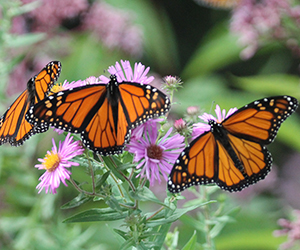Schoolyard Habitat Grants
Schoolyard Action Grants Bring Educators, Kids, Community, and Nature Together.
Are you an educator with a project in mind that will connect students with the outdoors, enhance the schoolyard for wildlife habitat, and integrate nature into student learning in alignment with curricula? Grants from the New Hampshire Partnership for Schoolyard Action Grants program are available for schools and educational organizations with students from pre-kindergarten through grade twelve to help fund schoolyard nature-based projects.
Since 2016, the Partnership has supported over 68 educational organizations and distributed over $35,000 in funding throughout New Hampshire.
The New Hampshire Partnership for Schoolyard Action Grants includes the U.S. Fish and Wildlife Service New England Field Office, N.H. Project Learning Tree, the N.H. Fish and Game Department, and New Hampshire Audubon. The partnership was created to make it easier for school staff to apply for a grant to enhance the school yard. Now, a common grant application works for all four of the partner organizations and greatly simplifies the application process.
Examples of projects that have been funded by the partner organizations in the past include the establishment of pollinator gardens, creation of outdoor learning areas, installing solar-powered bird baths and replanting of school grounds with native plants that enhance wildlife habitat (view Native Plant). Other types of projects eligible for support include trail or pond building, citizen science activities, and water or bird feeding stations.
Grant Application Details
Grant Period: The 2024 Grant Round is now closed
Eligibility: New Hampshire schools and other education-based organizations that serve young children through-12th grade may apply.
2024 Focus: We will be using the Climate and Economic Justice Screening Tool developed by the US Council on Environmental Quality to prioritize projects that occur within, or serve a majority of students who live in, the disadvantaged communities identified by this tool.
Grant Award Amounts: Grant awards are between $1,000-$5,000.
Required Components:
- Project Proposals must follow the proposal application (see below) and be filled out entirely.
- Project Proposals must have a team of 3 or more people working on its planning and implementation. Teams may be comprised of all school staff or include community members.
- Project proposals must have support from the education administration and a plan for sustainability.
A Project Proposal should:
- Describe a plan for how the project will be integrated with school curricula; strong proposals will integrate multiple subject areas and involve students in its planning and implementation
- Identify the purpose and need for this schoolyard project.
- Provide an explanation of how students will use the outdoor space.
- Have realistic goals to complete a schoolyard project in a two-year period. We anticipate that the first year will be dedicated towards planning and the second year will be the implementation phase.
- Provide pictures of your current outdoor space.
The interactive map shows which US Census Tracts disproportionately experience at least one of the following burdens: Climate Change, Energy, Health, Housing, Legacy Pollution, Transportation, Water and Wastewater, and Workforce development. More information about how the tool was developed can be found at https://screeningtool.geoplatform.gov/en/methodology.
Need Help?
Need Help?
Contact NHFG education staff with questions
Did You Know?
Did You Know?
NH Schoolyard Action Grants are made possible through financial support from the following: The Wildlife Heritage Foundation of NH, US Fish and Wildlife Service Partners Program, NH Project Learning Tree, and NH Environmental Educators.




